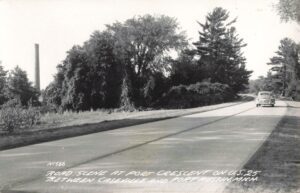PORT CRESCENT, Mich. — On a quiet stretch of U.S. Route 25, between Caseville and Port Austin, lies the ghost of a vanished town. A 1940-era real photo postcard captures the scene: a car cruising along the open road, flanked by pine trees and dense brush. Rising from the greenery, barely noticeable unless you know what to look for, stands a lone brick chimney—the last remnant of the once-thriving town of Port Crescent.
Founded in the 1860s, Port Crescent emerged as a booming lumber and salt production hub on the shores of Lake Huron. Built at the mouth of the Pinnebog River, the town flourished with the establishment of a massive sawmill operated by Pack, Woods & Company, later known as the Port Crescent Salt and Lumber Company. The mill processed timber from Michigan’s once-vast white pine forests and powered its operations using steam and river access. At its peak, the community boasted a population of over 500, with homes, businesses, a brewery, newspaper office, and even a short rail line linking it to other Thumb-area settlements.
But as quickly as it rose, Port Crescent fell.
By the 1890s, the timber was gone. The sawmill closed. Fires ravaged parts of the town. And by the early 1900s, most residents had moved on in search of work elsewhere. The land was gradually reclaimed by forest and sand. Only the towering smokestack of the sawmill—constructed of brick and built to withstand time—remained.
The real photo postcard, marked “Road Scene at Port Crescent on U.S. 25 Between Caseville and Port Austin, Mich.”, dates to about 1940. It provides an eerie glimpse into a Michigan landscape transitioning from industrial might to natural stillness. A concrete road cuts through the trees. The chimney looms to the left. If you didn’t know its story, you might drive by without giving it a second thought.
In the decades following this photograph, the site gained renewed attention. In the 1950s, Huron County and the State of Michigan began purchasing land around the site to form Port Crescent State Park. The park officially opened in 1959, preserving the beach, dunes, and woods that once echoed with the sounds of steam engines and saw blades.
Today, little remains of the original townsite. The chimney was eventually removed in the 1970s due to safety concerns. Nature has taken back what industry once claimed. But for those who know the history—or who pause long enough to study an old postcard—Port Crescent still lingers in memory.




